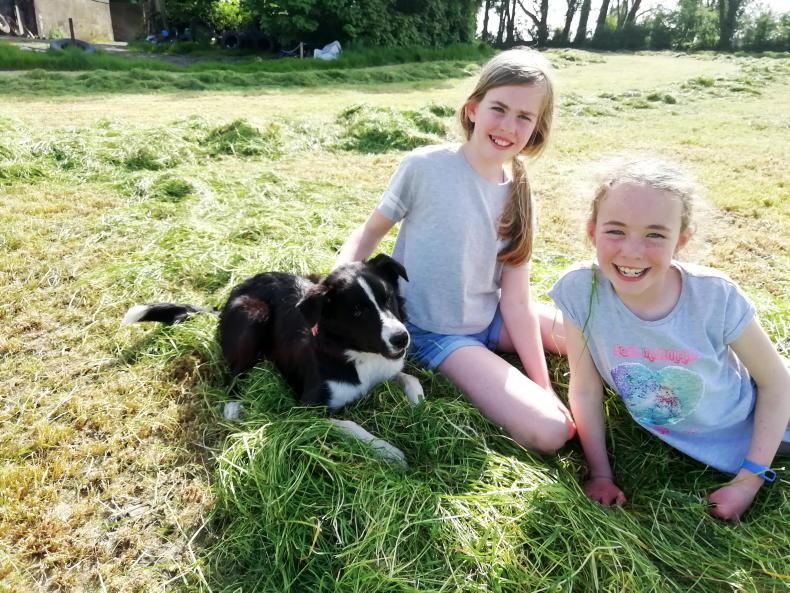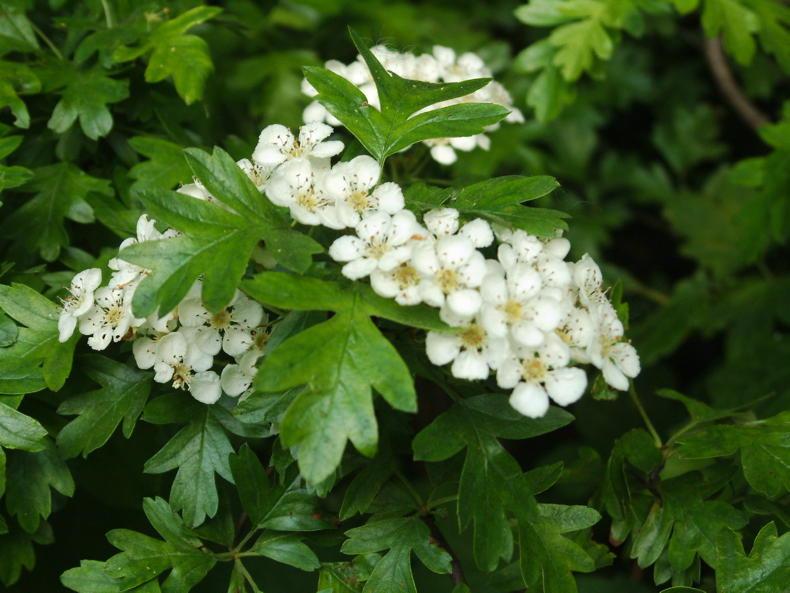
Silage inspectors: Katelyn and Dervla Desmond with their dog Sparky checking out the silage to see if it ready for picking up in Newcestown, Co Cork.
Turf cutting with my father part 2
By Trevor Johnston
As I look back.
I see him still.
Carving lumps of
black gold
His wife stands calmly
On the lowest floor.
Lifting the sodden lumps
Onto the wooden flat bottomed barrow
I stood patiently behind
The splintered shafts.
Soon the barrow
would be full
And I would wheel it carefully
Across the moss
To be unloaded by young
Nimble hands.
Their work now begun.
There would be no more
Chasing
Dragon flies and butterflies
Across the broad expanse
I wheeled the barrow
Back to the bog hole
And the cutting chores resumed.
Down past the first
two floors
To the rich black turf
Nature’s caviar of the bog.
Morning rolled into dusk
No chatter.
Too tired to even
Move our lips.
We massaged our tired
sun burnt limbs
And aching backs
We would eat well,
Sleep well.
Knowing that our
honest toils
Would warm the
Winter nights.
I dream of those days
Of honest toil.
A tear streams down
my cheek
As I stand and ponder
at the now
Broken body of my father
Who can no longer
Lift a spoon
Never mind a sleán.
Growing Wild with Dr Catherine Keena, Teagasc countryside management specialist

Whitethorn flower
Look out for whitethorn with white flowers on green palmate or lobed leaves. The May blossom – often featuring in photos of the first silage cutting and photos of the Irish countryside – is synonymous with our farmed landscape.
Known as whitethorn by farmers and rural people, it is also called hawthorn – which is why all trees and plants have an official Latin name.
A mature whitethorn is one of the loveliest of trees, but seldom allowed grow into the magnificent tree it can become. Supporting 62 larger Irish moth species – it is part of our native Irish biodiversity.
Katherine's home management tip:
Neutral, light colours are all the rage and it is difficult to keep paintwork clean from the wear and tear marks of everyday life. It is particularly so when toddlers and small children are about with sticky fingers.
A good trick is to apply a coat of water based varnish over the new paint. Do wait a few days to make sure the paint is completely dry. Go up about a metre high with the varnish, fading it out gradually.
A good paint brush is necessary to be able to apply a light coat of varnish. You will be able to wipe it clean with ease. It will last for years. If you want to paint over it at any stage, give it a good wash with sugar soap and off you go again.
We only have today and nobody knows what tomorrow will throw at us. That’s the way I look at life, and if there’s a bad day, it only lasts 24 hours and it usually never lasts that long. You have to break it down. So that’s my resilience – Mairéad O’Sullivan, on living with cancer

Silage inspectors: Katelyn and Dervla Desmond with their dog Sparky checking out the silage to see if it ready for picking up in Newcestown, Co Cork.
Turf cutting with my father part 2
By Trevor Johnston
As I look back.
I see him still.
Carving lumps of
black gold
His wife stands calmly
On the lowest floor.
Lifting the sodden lumps
Onto the wooden flat bottomed barrow
I stood patiently behind
The splintered shafts.
Soon the barrow
would be full
And I would wheel it carefully
Across the moss
To be unloaded by young
Nimble hands.
Their work now begun.
There would be no more
Chasing
Dragon flies and butterflies
Across the broad expanse
I wheeled the barrow
Back to the bog hole
And the cutting chores resumed.
Down past the first
two floors
To the rich black turf
Nature’s caviar of the bog.
Morning rolled into dusk
No chatter.
Too tired to even
Move our lips.
We massaged our tired
sun burnt limbs
And aching backs
We would eat well,
Sleep well.
Knowing that our
honest toils
Would warm the
Winter nights.
I dream of those days
Of honest toil.
A tear streams down
my cheek
As I stand and ponder
at the now
Broken body of my father
Who can no longer
Lift a spoon
Never mind a sleán.
Growing Wild with Dr Catherine Keena, Teagasc countryside management specialist

Whitethorn flower
Look out for whitethorn with white flowers on green palmate or lobed leaves. The May blossom – often featuring in photos of the first silage cutting and photos of the Irish countryside – is synonymous with our farmed landscape.
Known as whitethorn by farmers and rural people, it is also called hawthorn – which is why all trees and plants have an official Latin name.
A mature whitethorn is one of the loveliest of trees, but seldom allowed grow into the magnificent tree it can become. Supporting 62 larger Irish moth species – it is part of our native Irish biodiversity.
Katherine's home management tip:
Neutral, light colours are all the rage and it is difficult to keep paintwork clean from the wear and tear marks of everyday life. It is particularly so when toddlers and small children are about with sticky fingers.
A good trick is to apply a coat of water based varnish over the new paint. Do wait a few days to make sure the paint is completely dry. Go up about a metre high with the varnish, fading it out gradually.
A good paint brush is necessary to be able to apply a light coat of varnish. You will be able to wipe it clean with ease. It will last for years. If you want to paint over it at any stage, give it a good wash with sugar soap and off you go again.
We only have today and nobody knows what tomorrow will throw at us. That’s the way I look at life, and if there’s a bad day, it only lasts 24 hours and it usually never lasts that long. You have to break it down. So that’s my resilience – Mairéad O’Sullivan, on living with cancer








 This is a subscriber-only article
This is a subscriber-only article









SHARING OPTIONS: